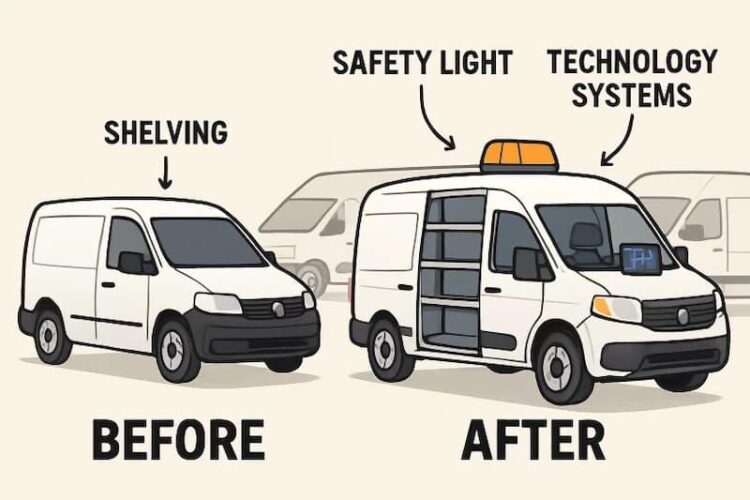Understanding Upfitting in Fleet Management
Upfitting is a transformative practice in fleet management, going far beyond routine modifications. It refers to the intentional and strategic process of altering vehicles beyond their factory specifications to serve better a business’s unique requirements and the particular demands of their industry. Whether by adding racking systems for enhanced organization on service vehicles or upgrading interior comfort features to improve the experience for drivers and passengers, upfitting enables companies to shape their fleets into finely-tuned, purpose-driven assets. Businesses increasingly rely on upfitting to unlock new levels of efficiency, minimize operational downtime, and sustain a fleet that is agile and reliable in dynamic markets. The right upfitting partner can be crucial in identifying and implementing these solutions. If your company is in need of experienced insight or a full range of upfitting solutions tailored to your fleet’s specific needs, TC Upfitting provides services aimed at enhancing both performance and long-term value. To learn more, explore how their expertise can support your operational goals.
Upfitting is not just a technical upgrade—it’s a holistic approach to aligning a fleet with the precise needs, workflows, and goals of a business. It often involves integrating specialized equipment, such as ladder racks, reinforced cargo protection, custom storage modules, and climate control systems for temperature-sensitive deliveries. Additionally, upfitting might extend to the installation of digitally connected tools that empower teams to operate more efficiently while ensuring vehicle longevity. As markets and regulations evolve, the adaptability and innovation delivered by upfitting have become central to how businesses meet unique challenges. In this way, upfitting directly supports a company’s ability to remain ahead of the curve, providing the adaptability and responsiveness essential for sustained operational success.
Enhancing Efficiency Through Customization
At its core, upfitting enables true customization, allowing each fleet vehicle to be crafted for peak efficiency in its designated role. When technicians, for instance, can store tools and parts in precisely designed shelving systems, productivity soars. An organized van minimizes wasted time searching for equipment, reduces misplaced inventory, and ensures that every item is easily accessible. The result is a streamlined workflow at every job site, allowing more calls to be completed each day and reducing employee frustration. This kind of workflow-oriented upfitting not only keeps jobs on schedule but also drives improvements in overall fleet utilization rates.
Beyond service fleets, the impact of upfitting is perhaps even greater in the logistics and delivery industries. Here, the on-time delivery of goods can determine a company’s reputation. By specifying temperature-controlled storage or installing refrigeration for pharmaceuticals, fleet operators ensure delicate cargo arrives safely and in perfect condition. Loading ramp installations accelerate delivery route stops by simplifying the loading and unloading process, offering a clear operational advantage. Each modification is a targeted improvement that eliminates common pain points and bottlenecks enhances driver morale and ultimately boosts customer satisfaction by consistently delivering reliable, efficient service.
Improving Safety and Compliance
Safety is an uncompromising priority in fleet management, and upfitting has become a vital tool for achieving superior safety standards while ensuring regulatory compliance. Modern upfitting trends have embraced the integration of advanced safety technologies, including backup cameras, collision warning systems, blind spot sensors, and superior lighting arrays that illuminate challenging environments. These enhancements empower drivers with greater situational awareness, reducing accident risk on the road and during job site operations. Additionally, cargo protection solutions such as secure lockboxes and reinforced partitions safeguard both personnel and valuable assets, mitigating risks associated with theft or shifting loads.
Keeping pace with stringent industry regulations is paramount, especially for fleets operating in sectors such as hazardous materials, pharmaceuticals, or construction. Upfitting can be tailored to ensure compliance with all government and insurance requirements, from installing fire suppression equipment to custom storage for hazardous materials and spill containment features. Companies that invest in these safeguards through upfitting not only mitigate regulatory and liability risks but also foster a proactive safety culture that supports employee retention, reduces insurance premiums and maintains a spotless legal track record.
Achieving Cost Savings and ROI
Upfitting a fleet is a substantial investment, but one that consistently delivers extensive long-term gains. Vehicles customized for the specific rigors of their work environments tend to experience far less wear and tear, enjoying longer service intervals and requiring fewer costly repairs. Through reduced downtime, optimized vehicle utilization, and improved employee productivity, companies experience tangible operational savings. Over the fleet’s lifespan, these efficiencies add up, delivering an exceptional return on investment. Rather than facing costly retrofits or replacements, businesses benefit from vehicles built for the task at hand from day one.
The marketplace for upfitting partners continues to expand as vendors innovate to meet the evolving needs of different industries. Companies such as Ranger Design have emerged as leaders by offering tailored, sector-specific solutions that address a broad spectrum of operational challenges. Their recent expansion highlights the growing recognition among fleet managers that professional upfitting is a catalyst for profitability and operational excellence. Fleet operators interested in strategic upfitting solutions can read more about market trends and Ranger Design’s latest initiatives in their latest update, which details the company’s commitment to industry-focused innovation.
Leveraging Technology in Upfitting
The rapid evolution of connected and digital technologies is fundamentally altering the fleet upfitting landscape. Telematics platforms, for example, equip fleet managers with the tools to monitor a vehicle’s real-time performance, track driver habits for safety coaching, and generate predictive maintenance alerts to preempt disruptive breakdowns. These analytics-driven insights help organizations minimize unscheduled downtime, optimize maintenance schedules, and control costs more effectively. Route optimization technology further reduces transit times, conserving fuel, lowering emissions, and supporting sustainability targets, while also ensuring prompt deliveries and enhanced client satisfaction.
Full-scale integration of hardware and software is becoming the new norm in upfitting. Advanced collaborations, like the partnership between Standard Fleet and UP.FIT, set a new benchmark for what is possible in vehicle customization. Together, they deliver innovative solutions such as bespoke electric vehicle modifications—imagine Tesla vehicles adapted specifically for public sector needs, seamlessly connected with the latest fleet management technology. This kind of next-generation upfitting isn’t just about aesthetics or operational tweaks; it’s about future-proofing fleets by integrating sustainable technology, automation, and connectivity at every level. For an in-depth look at how these innovations are shaping tomorrow’s fleets, read about the Standard Fleet and UP.FIT partnership.
Conclusion
The impact of upfitting on fleet operations is profound and far-reaching. It is not simply a collection of vehicle upgrades, but a strategic effort to align a fleet with the specific needs and aspirations of a business. By methodically customizing vehicles for their intended roles, embedding up-to-date safety technologies, and harnessing digital innovation, companies are able to ensure their fleets are adaptable, compliant, and efficient. In a rapidly changing business landscape, the right upfitting strategy—supported by experienced partners can deliver unparalleled ROI, end-to-end operational efficiency, and the agility required to thrive now and in the future. As industries continue to evolve, upfitting offers businesses the unique advantage of a fleet that is always ready to meet new challenges with confidence and capability.














